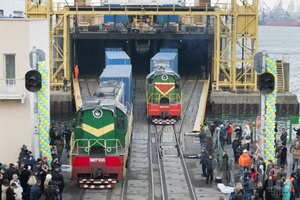
Oleksiy Volovych
Information about the first Ukrainian train, which January 31 arrived at Dostyk station at the Kazakhstan-China border, has become a kind of sensation, and caused a lot of different comments. Particularly it was emphasized that the train was “bypassing Russia”. In Russian media, this circumstance even caused mild hysteria from some authors who called Kazakhstan and China “traitors”. Ukrainian media, in my opinion, rightly described this event as an achievement of the Ukrainian government after months of complex and difficult enough preparatory work and consultations with Georgian, Azerbaijani, Kazakh, Turkish and Chinese partners.
As you know, January 15, Ukrainian Ferry “Heroes of Shipka” with the train on board (consisting of 10 wagons and 20 forty-foot containers) headed from Ilyichivsk (Black Sea) to the Georgian port of Batumi. Then, through the territory of Georgia, Azerbaijan, on another ferry across the Caspian Sea and Kazakhstan, January 31 the train arrived at its destination — Dostyk station on the border with China, having covered 5.5 thousand kilometers. The time of following this route was 15.5 days instead of the previously forecasted 11-12. Delays occurred in the Black Sea due to the storm, which the train had to wait out in the Bulgarian port of Varna, as well as due to downtime at Kazakhstan's Zhanaarka station due to untimely payment of transit.
February 2, at the office of UkrZaliznytsia, under the chairmanship of Prime Minister of Ukraine A. Yatsenyuk, was held a meeting, which analyzed the “bottlenecks” along the route of the test train and possibilities of their elimination in future work. The final testing of the organization of container trains on the entire route is supposed to be completed in late February. At the same time in Astana, there will be a meeting, during which the final agreement between the project participants from all countries will be signed. This will allow to finalize the work of all participants of the route in order to avoid delays in the future. In particular, the time of the train's running on the territory of Kazakhstan (section of the route stretching more than 3,000 km) could take not more than 3 days. It is forecasted that in the future, the time of following the whole route will not exceed 10 days.
As this event caused a lot of publications, we will not retell them, but will try to outline only the geopolitical context in which the event took place, and in general came true. There is no doubt, that the final word in the activation of the Trans-Caspian “Silk Road” route was that of Beijing, because without China and its enormous possibilities this road would have been out of the question. First of all, let's try to understand the following: why has China chosen the Trans-Caspian route on which Russia geographically and physically is not present? Why are the Trans-Siberian Railway and BAM not enough for China to transport its goods to Europe? Why doesn’t Russia fulfill its part of construction of the International Transport Corridor “Europe-Western China” (ITC EWC)? What prevails in China's decision to activate the Trans-Caspian route — politics or economy, and is it possible to qualify cooperation of Russia's “closest allies” — China and Kazakhstan with Ukraine and Turkey as a “betrayal” of Moscow in its confrontation with Kyiv and Ankara?
TRACECA. For the first time the phrase “bypassing Russia” was voiced at the Conference held in Brussels in May 1993 with the participation of Trade and Transport Ministers from eight countries of Central Asia and the Caucasus which started the European Union's interregional program TRACECA (Transport Corridor Europe-Caucasus-Asia) for the development of a transport corridor from Europe through the Black Sea, Caucasus and the Caspian Sea with access to Central Asian countries. Later the Program was joined by Ukraine, Mongolia, Moldova, Bulgaria, Romania, Turkey, Iran and Lithuania, as observers. Russia was not invited to participate in the Program TRACECA, because the political purpose of this Program was to help the countries of Central Asia and the Caucasus to find transit routes, alternative to Russian ones.
 September 8, 1998, in Baku there took place an international Conference “TRACECA — restoration of the historic Silk Road”, the participants of which signed a “Basic Multilateral Agreement on International Transport for Development of the Europe-the Caucasus-Asia Corridor”. Today, within the framework of the TRACECA program, the European Commission has financed over 70 projects to develop transport infrastructure of participating countries amounting to more than 1 billion Euros.
September 8, 1998, in Baku there took place an international Conference “TRACECA — restoration of the historic Silk Road”, the participants of which signed a “Basic Multilateral Agreement on International Transport for Development of the Europe-the Caucasus-Asia Corridor”. Today, within the framework of the TRACECA program, the European Commission has financed over 70 projects to develop transport infrastructure of participating countries amounting to more than 1 billion Euros.
During the 23 years of action of the TRACECA program, a certain infrastructure was created and standard rules were developed of multi-modal transport links between the countries of Central Asia, the Caucasus and Europe. At the end of 2012 was developed a railway transport corridor Europe-Caucasus-Asia along the route from China to Urumqi through Kazakhstan's Dostyk to Aktau port on the Caspian Sea, and from there by ferry to the Azerbaijani port of Alyat and further by railway through Azerbaijan to the Georgian Batumi and then by ferry to Istanbul.
However, this route, known as “Silk Wind” really began functioning only in August 2015, when the first Chinese container train July 28 departed from Shihezi province and arrived in Baku International Sea Trade Port August 3 having covered in 6 days a distance of 4.5 thousand km. Another Chinese freight train arrived in the Georgian capital Tbilisi, December 13, 2015. Thus, only China's de facto participation in the TRACECA program has breathed life into the Trans-Caspian route “Silk Road”.
Construction of New “Silk Roads”
Even five years ago, experts predicted that in 20-30 years China could overtake the United States and leave Russia far behind in terms of GDP and the volume of foreign trade. But it happened much earlier. Already today, China has overtaken the United States and left Russia far behind by the above-mentioned indicators. Before our eyes, China is becoming a superpower, the super-economy of which requires huge amounts of natural resources that China has to import from dozens of countries. For shipping to the country of hundreds of millions of tons of natural resources (energy, mining, food and other), as well as for foreign trade with dozens of countries around the world it needs an extensive network of modern transport communications.
 In order to create such a network in September 2013, Beijing unveiled a program of the “Economic Belt of the Silk Road” (EBSR), which provides for creation of a transport, energy and trade corridor between China and the countries of Central and South Asia, Australia, Europe, Africa and America. Thus, the object of the Program is actually the whole world. Road-building technologies in China are on the highest level. China ranks second in the world (after the USA) by the length of the network of railways and roads, while a great part of them is transferred to the speed limit — for railways 300 km/h and for motorways — 200 km/h. Today, more than 60 countries are interested in participating in EBSR program.
In order to create such a network in September 2013, Beijing unveiled a program of the “Economic Belt of the Silk Road” (EBSR), which provides for creation of a transport, energy and trade corridor between China and the countries of Central and South Asia, Australia, Europe, Africa and America. Thus, the object of the Program is actually the whole world. Road-building technologies in China are on the highest level. China ranks second in the world (after the USA) by the length of the network of railways and roads, while a great part of them is transferred to the speed limit — for railways 300 km/h and for motorways — 200 km/h. Today, more than 60 countries are interested in participating in EBSR program.
At present, China is building high-speed railways and roads in dozens of countries, especially those that are of interest for the Chinese economy. In most cases, Chinese companies build abroad road on DBFO (Design, Build, Finance and Operate) conditions, when Chinese companies are engaged in the design, construction, financing and management of roads. This way, along the entire length of roads, industrial infrastructure is created, owned fully or partially by the Chinese companies, which are instruments for promoting China's economic interests abroad. At the same time, China makes agreements with the States on the construction of high-speed railways and roads in exchange for local resources — energy, ore and agricultural.
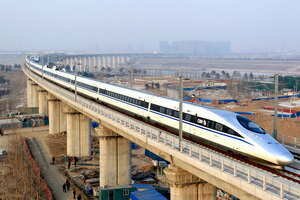 China plans to build several grand transcontinental speed railways “Railway Europe-Asia” for the following three main routes: 1) London-Paris-Berlin-Warsaw-Kyiv-Moscow, after which the road will be divided into two branches, one to Kazakhstan and the other — to Khabarovsk and Manchuria; 2) China-Singapore via South-East Asia; 3) China — the United States through the Eastern Siberia, the Bering Strait (through the tunnel about 200 km long), Alaska and Canada. According to preliminary calculations, the length of the railway along the route China-the United States will be about 13 thousand km, average speed — 350 km/hour, travel time between the end points will be 46-48 hours. It is expected that after the construction of the transcontinental high-speed railways China's trade with the countries located along each of the three routes will exceed 1 trillion US dollars.
China plans to build several grand transcontinental speed railways “Railway Europe-Asia” for the following three main routes: 1) London-Paris-Berlin-Warsaw-Kyiv-Moscow, after which the road will be divided into two branches, one to Kazakhstan and the other — to Khabarovsk and Manchuria; 2) China-Singapore via South-East Asia; 3) China — the United States through the Eastern Siberia, the Bering Strait (through the tunnel about 200 km long), Alaska and Canada. According to preliminary calculations, the length of the railway along the route China-the United States will be about 13 thousand km, average speed — 350 km/hour, travel time between the end points will be 46-48 hours. It is expected that after the construction of the transcontinental high-speed railways China's trade with the countries located along each of the three routes will exceed 1 trillion US dollars.
Perhaps a question may arise: why should China build a new railway line from Beijing to Moscow, 7000 km long through Kazakhstan, if there is the longest in the world (11 thousand kilometers) Trans-Siberian Railway with the Baikal-Amur Mainline, by which China has long been transporting its goods to the West? Yes, the Trans-Sib and BAM still exist, but rather as monuments to Komsomol construction projects of the last century. Today, it takes 45 days or more to transport cargo from China to Moscow by the Trans-Sib. The problem is that the Trans-Siberian Railway is quite slow and costly. The average speed of trains on the Trans-Siberian Railway and BAM is 15-30 km/hour. In general, cargo by Russian railways travels 5-7 times slower than in China, which is a world leader in the organization of high-speed railway traffic over long distances. Apart from this, tariffs for the transit of goods on the Trans-Siberian Railway are very high. To deliver by the Trans-Sib a 20-foot container from China to Moscow, you need to pay 6300 US dollars. It is easier and twice cheaper to carry Chinese goods to Russia by sea around India, through the Suez Canal, the Mediterranean Sea, the English Channel and the Baltic.
It should be noted that Moscow is not particularly enthusiastic about the idea of building the above-mentioned new railways from Beijing to Moscow via Kazakhstan, fearing that in this case most of the Trans-Siberian and Baikal-Amur Mainlines will remain unused, and will be used mainly for domestic traffic, which is unlikely to provide the profitability of these railways.
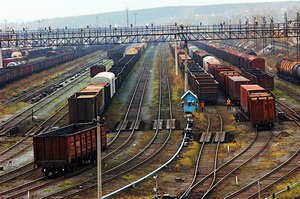 The Trans-Sib and BAM are physically and morally outdated and urgently need a radical modernization, to conduct which Russia should allocate 562.4 billion rubles until 2020. However, allocation of these funds keeps being delayed and trains on the Trans-Siberian and BAM railways continue running “slowly and sadly”, at 15 km/h. And obviously they will keep running like this for a long time. That is why the Chinese with the Kazakhs, Azerbaijanis, Turks and Ukrainians are forced to seek alternative ways on the route China-Europe bypassing Russia.
The Trans-Sib and BAM are physically and morally outdated and urgently need a radical modernization, to conduct which Russia should allocate 562.4 billion rubles until 2020. However, allocation of these funds keeps being delayed and trains on the Trans-Siberian and BAM railways continue running “slowly and sadly”, at 15 km/h. And obviously they will keep running like this for a long time. That is why the Chinese with the Kazakhs, Azerbaijanis, Turks and Ukrainians are forced to seek alternative ways on the route China-Europe bypassing Russia.
The “Silk Road” from China to Europe
The main idea of the project “Silk Road” is to create a competitive extensive network of routes in any direction. The more routes — the better, the more opportunities for China to maneuver forces and means to spread its influence and interests in the world. Until now, transportation between China and Europe is carried out mainly by sea through the Suez Canal. This route is 24 thousand kilometers, the delivery of goods by it takes 40-45 days. At present, 100 times less cargo is coming from China to the EU by land than by sea.
The “Silk Road” in the western direction, according to China's plans, has three options. The first option — from Kazakhstan, Azerbaijan and Georgia and then by ferry across the Black Sea — to Istanbul, Varna, Constanta and Odesa. The second — to the south of the Caspian Sea through Kyrgyzstan, Uzbekistan, Turkmenistan, Iran and Turkey. And the third — through Kazakhstan, through the territory of Russia to Moscow and St. Petersburg. China obviously prefers the first option as it has plans to build a bridge across the Caspian Sea from Kazakhstan to Azerbaijan.
The need to develop routes of the “Silk Road” in western direction is due to the rapid increase in the volume of trade between the EU and China, whose turnover in 2014 amounted to 470 billion Euros. In the implementation of the “Silk Road” project on the above-mentioned three routes, the trade turnover between China and the European countries can be doubled and would exceed 1 trillion Euros. Transportation of goods by land routes would allow to reduce the travel time to 10-12 days. In the first stage of implementation of the world's largest transit transport project Beijing intends to invest 40 billion US dollars.
The Russian-Chinese Project of a High-Speed Highway
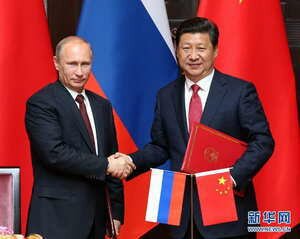 Discussion of the project of a high-speed highway between Europe and China began in the early 21st century. In 2008, the Presidents of Russia and Kazakhstan signed a Memorandum of Cooperation, involving the development of the international transport corridor Europe-Western China. Silk Road Fund Co Ltd was created for this purpose. However, no Russia's concrete actions have followed. Only September 3, 2015, during the visit of Russian President V. Putin to China, a memorandum was signed on the construction by 2023 of a new expressway (8.4 thousand kilometers long): the port of Lianyungang on the Chinese coast of the Yellow Sea coast — Martuk (North Kazakhstan)-Orenburg-Ulyanovsk-Kazan-Moscow. Further the route is to be divided into two directions: one — to Smolensk, via Belarus to Poland, and the other — to St. Petersburg. It was assumed that part of the motorway sections on the territory of Russia would be reconstructed and part would be built.
Discussion of the project of a high-speed highway between Europe and China began in the early 21st century. In 2008, the Presidents of Russia and Kazakhstan signed a Memorandum of Cooperation, involving the development of the international transport corridor Europe-Western China. Silk Road Fund Co Ltd was created for this purpose. However, no Russia's concrete actions have followed. Only September 3, 2015, during the visit of Russian President V. Putin to China, a memorandum was signed on the construction by 2023 of a new expressway (8.4 thousand kilometers long): the port of Lianyungang on the Chinese coast of the Yellow Sea coast — Martuk (North Kazakhstan)-Orenburg-Ulyanovsk-Kazan-Moscow. Further the route is to be divided into two directions: one — to Smolensk, via Belarus to Poland, and the other — to St. Petersburg. It was assumed that part of the motorway sections on the territory of Russia would be reconstructed and part would be built.
September 3, 2015 in Beijing, was also signed a memorandum between the Russian Avtodor State Company and China Development Bank (CDB), providing for the involvement of Chinese designing and manufacturing companies to implement the “Avtodor” projects, including the direct supplies of Chinese road construction equipment to Russia. Taking into consideration the lack of free capital in Russia due to international sanctions and falling oil prices, it was assumed that part of the construction of highways ITC EWC in Russia (more than 2.3 thousand kilometers) would be funded by Chinese investors.
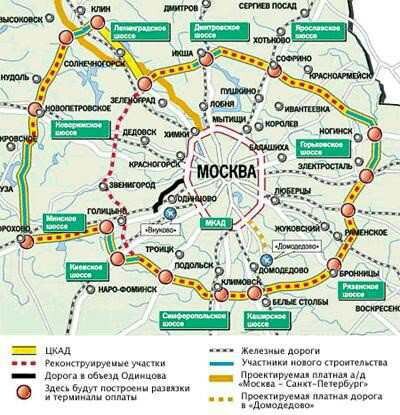 The highway will detour Moscow by the Central Ring Road (CRR), which should be partially put into operation within three years. Starting the motorway section from Moscow to Kazan is scheduled for 2024. However, as of today, “Avtodor” practically has not started the construction of the highway mainly due to problems in the field of financing, coupled with the resonant scandals. For example, in August 2015 the Accounts Chamber of the Russian Federation accused the “Avtodor” of delaying the timing of the construction of the Central Ring Road, worth 300 billion rubles, of which 150 billion rubles were allocated from the National Welfare Fund, established to ensure the stability of the country's pension system. Instead of spending the funds on the construction of the Central Ring Road, “Avtodor” put them on deposit at Gazprombank. In May-June 2015 alone, the amount of accrued interest on this deposit amounted to 262 million rubles. I think that this scandal has largely diminished the desire of the “Avtodor”'s Chinese partners to cooperate with it. To all this, in January of this year it became known that the Russian oil and gas company “Rosneft”, the Board of which is headed by I. Sechin, close to V. Putin, had “lost” about 35 billion US dollars, paid to this company by the Chinese oil and gas company CNPC as an advance payment for the oil supplied to China.
The highway will detour Moscow by the Central Ring Road (CRR), which should be partially put into operation within three years. Starting the motorway section from Moscow to Kazan is scheduled for 2024. However, as of today, “Avtodor” practically has not started the construction of the highway mainly due to problems in the field of financing, coupled with the resonant scandals. For example, in August 2015 the Accounts Chamber of the Russian Federation accused the “Avtodor” of delaying the timing of the construction of the Central Ring Road, worth 300 billion rubles, of which 150 billion rubles were allocated from the National Welfare Fund, established to ensure the stability of the country's pension system. Instead of spending the funds on the construction of the Central Ring Road, “Avtodor” put them on deposit at Gazprombank. In May-June 2015 alone, the amount of accrued interest on this deposit amounted to 262 million rubles. I think that this scandal has largely diminished the desire of the “Avtodor”'s Chinese partners to cooperate with it. To all this, in January of this year it became known that the Russian oil and gas company “Rosneft”, the Board of which is headed by I. Sechin, close to V. Putin, had “lost” about 35 billion US dollars, paid to this company by the Chinese oil and gas company CNPC as an advance payment for the oil supplied to China.
Unlike Russia, Kazakhstan and China have met their obligations to create ITC EWC in time. On the territory of Kazakhstan, a highway (2.7 thousand kilometers) passes through the country from Martuk in the north to Khorgos in the south at the border with China. On the territory of China, as of December 2015, the highway from Khorgos-Urumqi-Lanzhou-Zhengzhou-Wuhan-the port is already built. The total length of the road is 3.4 thousand kilometers.
Moscow — as a Catalyst for the Development of the “Silk Road” Bypassing Russia
In our opinion, the confrontation between Russia and Ukraine and Turkey accelerated the implementation of the Trans-Caspian route “Silk Road”, which once again showed Russia's growing geopolitical isolation, as China and all the countries of Central Asia and the Caucasus did not take the side of Russia, but actually supported Turkey and Ukraine. After Moscow had banned the import of certain categories of goods from Turkey to Russia, as well as transit traffic through its territory between Kazakhstan and Turkey, Astana and Ankara agreed on the organization of transit traffic by ferries operating in the Caspian Sea between the ports of Aktau and Alyat and in the Black Sea between Batumi and Istanbul.
November 28, the day when V. Putin signed a decree on application of special economic measures against Turkey, “Russia's closest ally” China, together with Turkey, Kazakhstan, Azerbaijan and Georgia established a consortium for shipping cargo by Trans-Caspian Route: China-Kazakhstan-Azerbaijan-Georgia-Turkey- Europe, bypassing Russia. The agreement was signed by representatives of major transport companies in Istanbul where November 30, was held the presentation of the Trans-Caspian International Transport Route (TCITR), which was attended by representatives of large transport and logistics operators of Turkey, Kazakhstan, Azerbaijan, Georgia and Lithuania. We should point out that for some reason Ukraine did not participate in this presentation. Perhaps Lithuanian friends have told us about everything.
As part of this project in 2016, it is planned to transport through the territory of Georgia the first few thousand containers from China to Turkey and Europe. The parties also plan next year to start transporting goods through Ukraine to Northern and Eastern Europe within the framework of the emerging on the initiative of the President of Poland A. Duda, Baltic-Black Sea Alliance. The partners believe that by 2020, along the Trans-Caspian Route annually will be transported up to 50 million tons of cargo, 300 to 400 thousand containers.
January 14 in Baku heads of railways operators of Azerbaijan, Kazakhstan, Georgia and Ukraine signed a protocol on the establishment of competitive reduced tariffs for cargo transportation by TCITR. The document also provides for comprehensive measures to simplify the movement of trains and increase in freight volume by TCITR through which can pass up to eight trains per month. The common tariff policy for cargo transportation by TCITR will have been agreed between the four countries by the end of February.
The railway section from Akhalkalaki station in Georgia to Kars station in northeastern Turkey (105 km) has to be completed by the end of 2016. This project is part of a larger project for the connection of railways of the southern Caucasus to Europe via Turkey. In Istanbul, it has already been built the Marmaray underwater railway tunnel under the Bosporus Strait, which will provide a direct connection to the European railway network. Besides, in April 2016 will be completed construction of the third unique bridge over the Bosporus (2 km long, 60 m wide and 320 m high). The bridge has eight lanes for motor vehicles and two railway tracks. The cost of the project is 2.3 billion US dollars. The bridge will be connected to the 115-kilometer-long international highway, thus forming a single transport infrastructure with the third international airport of Istanbul (with passenger traffic of 90 million people per year), the construction of which is scheduled to be completed in 2018.
 One of the reasons for engaging the routes of the “Silk Road” bypassing Russia, is Moscow's having been blocking since January 2016 transit of goods from Ukraine to Central Asia and China. At this, Russia suggests that these countries should send their goods to Europe only through Belarus. In other words, Moscow is forcing Central Asian countries to restrict to a minimum their trade with Ukraine. This way the Kremlin has “punished” not only Ukraine, but also its main partner in the EAEC — Kazakhstan, 40 % of foreign trade of which is with the EU countries. At this, Kazakhstan and other Central Asian countries once again felt their vulnerability to Moscow's transit monopoly. Under these circumstances, they were forced to think about alternative transit routes of delivery of their goods to Europe. And one of the ways of transit became the Trans-Caspian route of the “Silk Road”.
One of the reasons for engaging the routes of the “Silk Road” bypassing Russia, is Moscow's having been blocking since January 2016 transit of goods from Ukraine to Central Asia and China. At this, Russia suggests that these countries should send their goods to Europe only through Belarus. In other words, Moscow is forcing Central Asian countries to restrict to a minimum their trade with Ukraine. This way the Kremlin has “punished” not only Ukraine, but also its main partner in the EAEC — Kazakhstan, 40 % of foreign trade of which is with the EU countries. At this, Kazakhstan and other Central Asian countries once again felt their vulnerability to Moscow's transit monopoly. Under these circumstances, they were forced to think about alternative transit routes of delivery of their goods to Europe. And one of the ways of transit became the Trans-Caspian route of the “Silk Road”.
* * *
Recent events around the revival of the “Silk Road” have shown the futility of V. Putin's hopes to establish common with China Common Economic Space (CES), in order to involve Beijing in political projects aimed against the West and especially against the United States. The matter is that for China relations with the United States are much more important than those with Russia, if nothing else, because in 2015 China's trade with Russia amounted to about 60 billion US dollars, while trade with the United States was 10 times greater — about 600 billion US dollars. Of the nearly 900 billion US dollars of China's foreign investments, Russian accounts for less than 1 %. Russian investments in China amount to only 900 million US dollars.
So, geopolitical interests and economic potentials of the Russian Federation and China differ so greatly that even Moscow's appeals to curb the common opponent (the United States) cannot resolve these contradictions. Initially very fragile, the Russian-Chinese alliance, is gradually weakening as the priorities of the two countries increasingly diverge on a number of questions, at both, the bilateral and international levels.
The Kremlin strategists' unbounded ambitions do not allow them to objectively estimate the real geopolitical situation in which Russia and China are today. The problem is that China is now rightly claiming to be the world's superpower, number 1, while Russia, having countless natural resources and a vast territory, nevertheless has rolled to the level of an ordinary regional power, the GDP of which is less than the GDP of Germany, Japan, India, not to mention the United States, China and the European Union. As the Chinese say, “Moscow's political ambitions are not supported by the economic base”.
Today in Beijing, they look at Russia as an object of economic expansion, as evidenced at least by the fact that Eastern Siberia and the Russian Far East, according to many estimates, are home to at least 10 million Chinese, and their number keeps growing. According to some forecasts, if the Chinese penetration into the territory of Russia continues at the current level, by 2050 the majority of Russia's population will be ethnic Chinese.
Making a “turn to the East” having worsened its relations with the West as a result of the aggression against Ukraine, the Kremlin is trying with the help of China to shift the center of world politics from the Atlantic and the West to Eurasia. As counterbalance to the geopolitical association “USA + Europe and Japan,” the Kremlin strategists planned to form a Eurasian common space: Russia EAEC + BRICS + China and Southeast Asia. However, to all appearances, such a geopolitical construction does not suit China, as China's relations with the West are more extensive and stable than those with Russia. Besides, some of these Russia's “allies and friends”, such as Kazakhstan, Kyrgyzstan, Tajikistan and Turkmenistan have already been in the sphere of China's magnetism which suits them. Some analysts and experts, including the well-known Russian economist, sociologist and politician V. Inozemtsev, believe that in the future Russia will also “get inevitably entrenched in the status of the slave” in the field of attraction of the Great China. Will it or it will not be so — depends on the Russian people.

